Rudolph occasionally stops by our house, and we enjoy our time with him. I didn’t want to post this on Christmas, because some might consider it in bad taste, but this year’s visit was particularly memorable.
We often make tamales over the holidays, and for the meat filler we toss together whatever is handy. This year the meat base was two nice pieces of caribou. Our recipe varies a lot from batch to batch. I aim for a final volume of about 3/4 of our 12-inch, deep, square-sided pan (Rose calls it the chicken pan; it’s a deep skillet with a second handle on the front).
Rudolph tamales
corn husks
Meat filler:
~4 lbs. caribou
chicken broth
some mild pork sausage
2.5 Tbsp chile flakes
lentils (optional)
mole (optional)
salt to taste
Masa:
2 C masa
2 C chicken broth
1 tsp baking powder
½ tsp salt
2/3 C lard or vegetable shortening
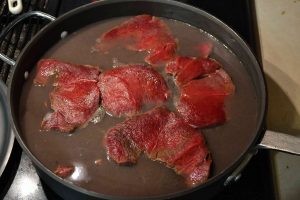 Set the corn husks to soak so they’re very pliable when used. Cut the meat so it cooks down to fall apart faster. You want it to be easy to flake. We toss in pork sausage to get a little fat in there; caribou is very lean and dry. We slowly simmer the meat covered in the broth with the spices for a few hours, adding the pork sausage in the last hour. Cook the lentils separately, adding about one part to 3-4 parts meat at the end. I blend up several types of dried chiles (e.g., guajillo, arbol, chilpotle), and the amount given is what I consider the minimum (the chiles pictured at the bottom equaled ~2.5 Tbsp when stemmed and blended). When using mole sauce, you want to use a bit less than when making mole, so you have a thinner liquid. When the meat is falling apart, remove it from the broth (which we save and use again for other dishes; this time it was chicken mole over rice). Flake the meat up good. Add lentils, mix, check for flavor, and get the masa ready.
Set the corn husks to soak so they’re very pliable when used. Cut the meat so it cooks down to fall apart faster. You want it to be easy to flake. We toss in pork sausage to get a little fat in there; caribou is very lean and dry. We slowly simmer the meat covered in the broth with the spices for a few hours, adding the pork sausage in the last hour. Cook the lentils separately, adding about one part to 3-4 parts meat at the end. I blend up several types of dried chiles (e.g., guajillo, arbol, chilpotle), and the amount given is what I consider the minimum (the chiles pictured at the bottom equaled ~2.5 Tbsp when stemmed and blended). When using mole sauce, you want to use a bit less than when making mole, so you have a thinner liquid. When the meat is falling apart, remove it from the broth (which we save and use again for other dishes; this time it was chicken mole over rice). Flake the meat up good. Add lentils, mix, check for flavor, and get the masa ready.
Combine masa, baking powder, and salt in a bowl, then add broth and work it all together to make a soft, moist dough. In a mixing bowl, beat the lard or shortening until it is fluffy. Then slow the beaters and add the masa and beat it until the dough is well mixed and somewhat springy. We usually double this batch right off and plan on making more batches as we use up the meat.
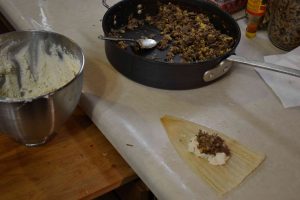 Now assemble the tamales. A large steamer is needed; fill the bottom with enough water for two hours of steaming. Get a comfortable assembly space set up so you have the meat, masa, and corn husks available beside an open space for assembly. Place an open corn husk on the counter, add a dollop of masa, then a dollop of meat, then wrap it up, fold the ends, and place it in the steamer so the weight of the tamale holds the folded ends closed.
Now assemble the tamales. A large steamer is needed; fill the bottom with enough water for two hours of steaming. Get a comfortable assembly space set up so you have the meat, masa, and corn husks available beside an open space for assembly. Place an open corn husk on the counter, add a dollop of masa, then a dollop of meat, then wrap it up, fold the ends, and place it in the steamer so the weight of the tamale holds the folded ends closed.
The size of each tamale is dictated mostly by the size of the corn husks. As you use up the best ones, you wind up artistically piecing two of them together to retain that approximate size. Masa:meat ratio is ~1-1.5:1; you will probably juggle this a bit as you gauge the remaining amounts of each so you wind up with nothing left over.
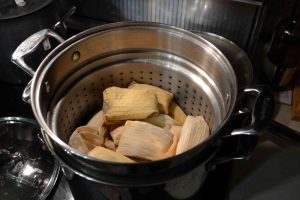 When the steamer is full or you’re done, put it on the stove and steam for two hours. (To prevent inadvertently running it dry, we put the burner on high until it is steaming, then turn it down to maintain a lower boil, judging by steam output.)
When the steamer is full or you’re done, put it on the stove and steam for two hours. (To prevent inadvertently running it dry, we put the burner on high until it is steaming, then turn it down to maintain a lower boil, judging by steam output.)
We really enjoy having fresh tamales when they’re done. Caribou is a dry meat, so we usually put some salsa or mole over the tamales as we plate them up (we don’t usually use much pork sausage in the meat mixture). We always make a lot more than we can eat, because it’s a big effort and our goal is to enjoy them throughout the year. So we vacuum pack the majority, four to a pack. And for some happy weekend lunches in the future, we’ll put them into a small steamer for ~20 minutes and serve them with eggs, hot chocolate, and fruit salad for what Rose calls the full tamale meal.
Rose and I do all this together, so it goes fairly quickly. But it still requires hours, so we often do it over two days. For example, this time I began the meat on Christmas Eve. Yes, we really enjoyed Rudolph’s visit.

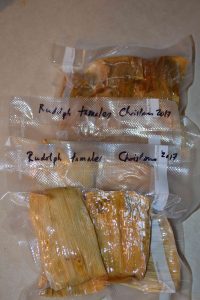
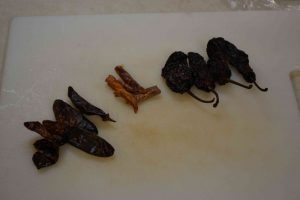
I’m so glad you posted this recipe.
I have it in your lovely chicken scratch handwriting and have never been able to make it because I can’t read it!
Glad you can use another version!